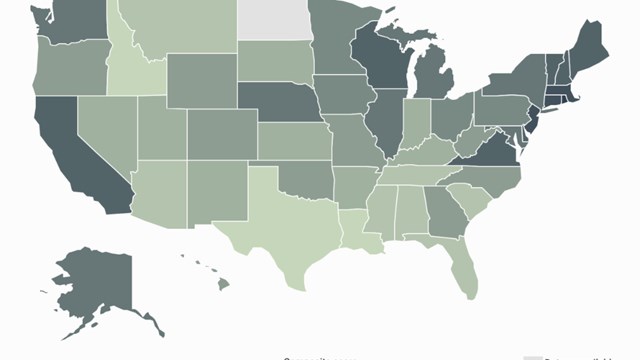Whether condo associations will buy into the so-called “electric highway” has become the perennial $64,000 question.
And the answer? The electric vehicle or EV revolution is coming, albeit slowly.
ChargePoint, Inc., which provides an online network of EV charging stations, has partnered with National Grid in announcing the first of more than 80 electric vehicle (EV) charging stations it will install around New York, through a $1 million incentive from the New York State Energy Research and Development Authority (NYSERDA), according to a ChargePoint press release. The first charging station of this project was installed at The Solaire, the first green apartment building in the United States, located in Battery Park City. Under Gov. Andrew Cuomo’s “Charge New York” initiative, there are plans to install 3,000 public and workplace charging stations by 2018.
“In the Albanese Organization, since 2003, we’ve always had car charging stations in our buildings—we were early adopters,” Michael Gubbins, the vice president of residential property management for the Albanese Organization, Inc. in Garden City, says. “In the early days, we put them in because it was another component we figured people may want to use in the future, even though there wasn’t a lot of use in the beginning—it was a symbol of the future.”
At some point, condominium owners and developers may decide to install charging stations, but right now, it’s difficult to find many condominiums with charging stations here. For condos, however, being “smart” may soon become a calling card.
Heat and air conditioning draw from the vehicle’s battery, resulting in a more frequent need to charge, but interest increases, regardless. “Buyers will simply use the car when it’s appropriate,” says Carly Kade, communications manager for eVgo Communications of Houston, Texas. She says consumers buy a car appropriate for travel on average days, regardless of where they live. According to eVgo, dedicated chargers for multi-family buildings are one of four primary needs for EV drivers (the others being range confidence (mileage per charge); standardized, transparent costs; and low upfront cost).
According to ChargePoint’s Anne Smith, director of public relations and communications, as of April 1st of this year, there are 119 registered EVs in New York County and 48 public charging stations located in Manhattan.
EVs in NYC
The EV trend seems to be spreading in the Big Apple city-wide. In April 2013, Mayor Michael R. Bloomberg partnered with Nissan to introduce six electric-powered LEAF vehicles to be used as taxis in the city. The project is part of a one year pilot program to explore how to implement electric vehicles into the city's fleet.
Bloomberg and Cuomo's big push toward EV is driven by the ultimate desire to make New York City a safer, less pollution-filled environment to live in. According to nyc.gov, 22 percent of New York's total greenhouse gas emissions are from transportation emissions. EVs lower urban heat, reduce vehicle noise (and urban noise overall) lower car carbon emissions and oil dependence (New Yorkers buy more than 380,000 gallons of gasoline a year).
“More and more drivers are turning to electric cars for cleaner transportation, reduced fueling costs and decreased dependence on foreign oil,” Smith says. “However,” she continues, “convenient places to charge are necessary for the adoption of electric vehicles. Most experts agree that a large part of charging will be done at home. Very simply, installing charging stations will attract quality tenants. Which is to say, property managers have a way to differentiate their property by offering a coveted amenity to conscientious tenants. There has been a huge surge of EV buying since the beginning of 2013 and there are now more than 100,000 EVs on the road in the U.S.”
Unless residents want to look at electric cords hanging over patio walls, charging stations may become imperative as usage grows. Fortunately, the federal government is offering incentives to assist with installation, and soon, to assist with upkeep and maintenance.
According to the National Conference of State Legislatures, while New York doesn't currently offer any monetary incentives to EV owners, there are several incentives proposed in Albany by the state Legislature, awaiting action. These include the New York Assembly’s A 569, which establishes a tax credit for the installation of electrical outlets for charging electric cars in certain parking garages; A 1377 and S 1665, which provide an exemption to the retail sale of plug-in hybrid electric vehicles from state sales and compensating use taxes; A 2379, which establishes the 2013 alternative fuel and electric vehicle incentive program, A 2465, which exempts new electric vehicles, clean fuel vehicles and vehicles that meet the clean vehicle standards from the first year of registration fees; and A 3230, which exempts electric vehicles from state sales and compensating use taxes and grants municipalities the option to provide such exemption.
In an effort to educate New Yorkers on all things EV and help ease the transition for new EV drivers, Con Edison has created a webpage dedicated to the subject (www.coned.com/ electricvehicles).
“The first thing we did was focus on customer education, and we developed an EV website that gives information on EVs and the types of EVs [available],” John Shipman, the department manager of electric vehicles for Con Edison, says. It’s important for the consumer to understand exactly the language that’s used out there relative to EVs. Also on the website, we discuss the different types of charging and different levels of charging that consume at different rates and depending on the vehicle, the charge times vary depending on the rate of charge. We’ve got a direct contact that comes back to me via email for people that have additional questions, so we can answer their specific questions one-on-one. It’s important that people understand what they’re trying to do and what their needs are in terms of miles per day and how often they need to be charged,” he adds.
Plugging In
According to eVgo, dedicated chargers for multi-family buildings are one of four primary needs for EV drivers (the others being mileage per charge, standardized, transparent costs and low upfront cost). One wonders how board members will handle the cost of electric charging stations for residents and just who will pay the cost for the electricity they consume. At some point, condominium owners and developers may decide to install charging stations. Suzanne Tamargo, a spokeswoman for the nationwide service Car Charging—the provider for Walgreen’s stations (the chain has installed public stations at many of its urban locations)—says that, while condominium associations may or may not charge, most public facilities have some kind of fee, even if it’s only for using the parking space allotted to a charging station. Some places charge by time, others by unit of energy
Boards will have to consider the cost if they do install chargers, and determine how non-electric car users fit in. The cost of supplying electricity varies, but typically runs about 50 cents to 75 cents an hour, according to Pike Research/Energy Market Intelligence.
In California, condo boards initially balked at installing EV stations until the law prodded them. The Luskin Center for Innovative Research at UCLA reports that boards disliked the cost of installing charging stations, which may vary from a low of $3,000 up to $15,000—especially when Level 1 is essentially the equivalent of running an extension cord from the dwelling.
However, billing for charging has recently become less complicated for New York-based multifamily buildings.
“The manufacturers of chargers make packages that are networked where they can actually do billing, so if a co-op or condo had a common space where they put in their chargers, they could apply for these services from network charger companies and they would handle all the sub-metering for them,” Shipman says. “Recent changes in the meter sub-metering rule have allowed building owners to charge separately for that electricity use, so that is a big step that the Public Service Commission has removed a hurdle on.”
Whose Place is It?
According to eVgo’s Kade, there are some challenges when it comes to situating charging stations in associations. For instance, for condominiums, the problem stems from parking spaces being deeded to individual owners. “We choose to deploy chargers in groups to keep the cost of the infrastructure as low as possible,” she says. “Therefore, we need to designate parking spaces that are not deeded, or where the HOA is willing to relocate existing parking assignments. We have had success in condominiums where they were willing to provide non-deeded space.”
J.R. DeShazo, director of the Luskin Center for Innovation at UCLA, says boards can take the simplest approach first. “Using what they already have is the smartest thing, and the cheapest thing, they can do. If there are 110-volt outlets, just utilize them. People can do that with a wall plug, and 95 percent of the vehicles will fully recharge overnight. Ten hours will give you 100 miles, so if you’re driving less than 60 miles a day, that’ll be fine.”
For example, a Level 1 charging station is just like a regular outlet. A Level 2 station is a fancy 240-volt outlet—like an electric dryer hookup. Installing electric vehicle chargers in most cases doesn’t even require a special permit beyond what one would need to install these outlets.
But, at Level 2, costs can become more “challenging.” DeShazo dubs this the battleground for condo boards, saying, “You might have to run wiring in an existing building.” He prefers that new installations or retrofitting an existing building offer conduits for electric charging, in case it is ever needed. Additionally, local building codes may need to be changed.
DeShazo also suggests condo boards can reassign parking spots so that electric vehicles will be close enough to use existing Level 1 plug-ins. “If that doesn’t work, then the ideal is to consider the building type, codes, etc., to see if it will allow residents to install their own charging space, and if possible pay the electric bill. It’s ideal to connect to an existing meter, but they might get two bills instead of one.”
Why should condo boards consider this? DeShazo says it’s mainly to be progressive and environmentally-friendly.
“We (in California) have about 45,000 EVs on our roads. So some buildings are marketing themselves as EV-friendly or EV-ready, meaning they have a unit with at least a 110-volt outlet. Condos tend to be really conservative. It’s hard to get them to do it … but being EV-friendly becomes simply another amenity they need to provide. Many make the investment and then figure out cost recovery.”
Ann Frantz is a freelance writer and a frequent contributor to The Cooperator. Editorial Assistant Enjolie Esteve contributed to this article.







Leave a Comment